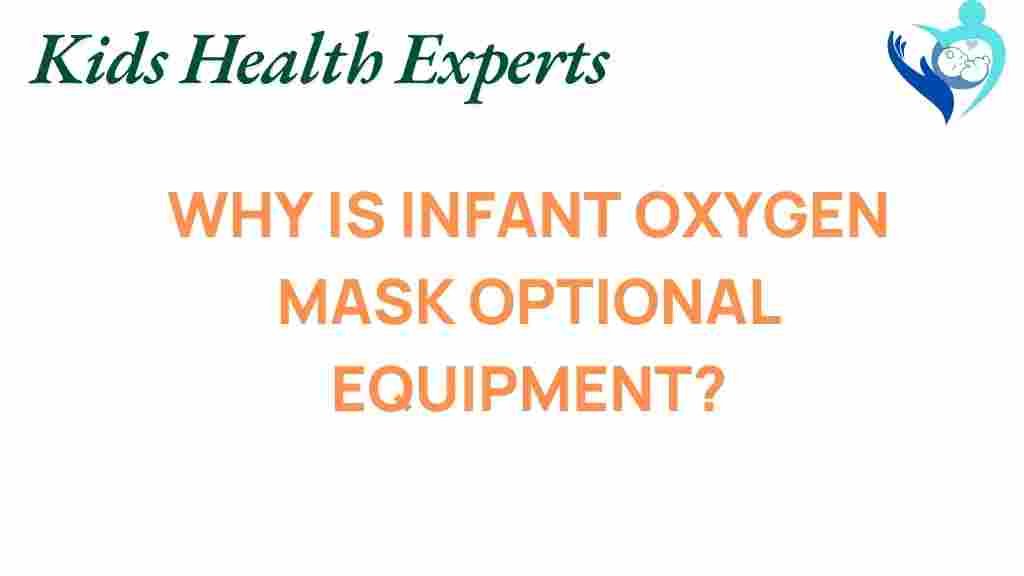The Surprising Case for Optional Infant Oxygen Masks in Care Settings
In the realm of pediatric care, ensuring the optimal respiratory health of infants is paramount. While oxygen therapy is a well-known intervention for respiratory distress, the use of infant oxygen masks in care settings is often met with skepticism. However, the case for having these masks available as an optional medical device can be more compelling than many healthcare professionals realize. This article explores the benefits, guidelines, and protocols surrounding the use of infant oxygen masks, emphasizing their role in newborn safety and effective emergency protocols.
Understanding Infant Oxygen Masks
Infant oxygen masks are specially designed pieces of medical equipment that deliver supplemental oxygen to newborns and infants who may be experiencing respiratory difficulties. These masks are crafted to fit comfortably on a child’s face, ensuring both effective delivery of oxygen and safety. Here, we will discuss why these masks are essential and how they can be used effectively in various healthcare practices.
Why Consider Optional Infant Oxygen Masks?
- Respiratory Distress Management: Infants, particularly those born prematurely or with underlying health issues, may experience acute respiratory distress. Having infant oxygen masks readily available can be a lifesaving measure.
- Quick Response in Emergencies: In emergency situations, time is of the essence. Optional oxygen masks ensure that healthcare providers can act swiftly to address respiratory issues.
- Improving Outcomes: Studies have shown that timely intervention with supplemental oxygen can improve outcomes for infants suffering from conditions like hypoxia or apnea.
- Ease of Use: Infant oxygen masks are generally easy to use, making them a practical choice for healthcare settings.
Implementing Optional Infant Oxygen Masks: A Step-by-Step Process
Integrating optional infant oxygen masks into care settings requires a systematic approach to ensure effectiveness and safety. Here’s how to implement these healthcare practices step by step:
Step 1: Assess the Need
Before implementing the use of infant oxygen masks, assess the specific needs of your care setting. Consider factors such as:
- Patient demographics (e.g., prevalence of respiratory issues)
- Current emergency protocols in place
- Availability of trained staff
Step 2: Train Healthcare Providers
Once the need has been established, it’s crucial to ensure that all healthcare providers are properly trained in the use of infant oxygen masks. Training should include:
- How to correctly fit the mask on an infant
- Understanding the indications for use
- Monitoring oxygen saturation levels
- Recognizing signs of respiratory distress
Step 3: Establish Protocols
Develop clear protocols for when and how to use infant oxygen masks. This should include:
- Criteria for initiating oxygen therapy
- Documentation procedures
- Follow-up care guidelines
Step 4: Source Quality Equipment
Ensure that all medical equipment, including oxygen masks, meets the required safety standards and is appropriate for use with infants. Considerations should include:
- Size and fit for different age groups
- Comfort and ease of application
- Quality assurance from manufacturers
Step 5: Monitor and Review
After implementation, continuously monitor the outcomes associated with the use of infant oxygen masks. Regular review meetings can help in:
- Identifying areas for improvement
- Sharing success stories and challenges
- Updating training and protocols as necessary
Troubleshooting Tips for Using Infant Oxygen Masks
Even with proper training and protocols in place, challenges may arise when using infant oxygen masks. Here are some troubleshooting tips:
Issue 1: Mask Discomfort
If an infant shows signs of discomfort while wearing the mask, consider the following:
- Check the fit: Ensure the mask sits correctly on the face without being overly tight or loose.
- Adjust straps: Make sure the straps are not causing irritation.
- Take breaks: Allow the infant to have short breaks from the mask if they seem distressed.
Issue 2: Inadequate Oxygen Delivery
In cases where oxygen delivery seems inadequate, verify:
- The oxygen source is functioning properly.
- The mask is not obstructed or leaking.
- Check the positioning of the mask on the infant’s face.
Issue 3: Monitoring Oxygen Saturation
If oxygen saturation levels are not improving:
- Reassess the need for supplemental oxygen.
- Consult with a pediatric specialist.
- Consider additional interventions as per emergency protocols.
Conclusion: Advocating for Infant Oxygen Masks
The discussion surrounding the use of infant oxygen masks in care settings is not just a matter of preference but one of necessity. With the ability to significantly impact newborn safety and respiratory health, these masks should be regarded as an essential component of pediatric care. By implementing proper training and protocols, healthcare providers can ensure that they are prepared for any respiratory emergency that may arise.
As with any medical intervention, the key lies in understanding when to use oxygen masks and how to do so effectively. By advocating for their optional use, we can enhance our emergency protocols and ultimately improve the quality of care we provide to our youngest patients.
For more information on pediatric care and health protocols, please visit this resource. If you’re looking for high-quality medical equipment, check out this supplier.
This article is in the category Care and created by KidsHealthExperts Team
